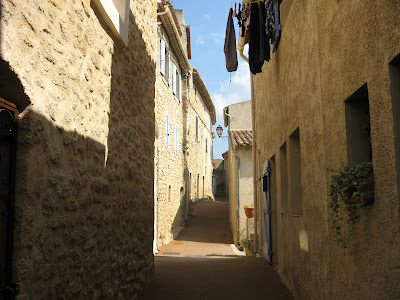The most outstanding feature of La Tour d'Aigues is the remains of its Renaissance chateau. Its gateway is still intact and takes the form of a splendid triumphal arch. It is a unique example of Renaissance architecture in Provence. The castle is being gradually restored and its cellars house a musee de faience (earthenware museum) with exhibits of earthenware found during the restoration. Just inside the gate are banks of seats for viewing the theatre, music and dance spectacles that are held there each summer. At the moment Alice in Wonderland is on there. We then took a look round the Church of Notre-Dame de Romegas. It is a 12th/13th century church with well worn walls and floors. It was almost pitch dark when we entered except for the light coming through the stained glass windows.
 |
| One of the side altars. |
We returned to La Motte for lunch and to await the arrival of Christine and Lucien's femme de menage, Catherine. Then we left her to her chores and set off for more of the villages.
Ansouis is classified as one of most beautiful villages in France. The village is dominated by the castle which is over 1000 years old.
Left and below the castle at Ansouis.
 |
| The view from the castle. |
The village has lots of little streets and alleyways, including a tiny one called Traverse Esquicho-Couido. It is extremely narrow at one end.
Above, Traverse Esquicho-Couido from the narrow end. Right Traverse Esquich-Couido from the broader end. Imagine being my size and being chased by something undesirable from broad end to narrow end - no escape for me!
 |
| A more normal sized narrow street. |
 |
| The side altar dedicated to Saint Elzear and Blessed Delphine. |
 |
| St. Martin Church. |
Next stop was a little village called Cucuron surrounded by olive trees and vineyards. There are several cooperatives in the village devoted to olive oil and wine production.
 |
| The belfry in Cucuron. |
 |
| 2 views of the castle. |
The centre of Cucuron has a large pool of water, called a bassin, but large enough to be a lake, in its main square shaded by towering 200 year old plane trees. Cucuron is also classified as one of the most beautiful villages in France. The 1995 film "Le Hussard sur le Toit" ("The Horseman on the Roof") was filmed there.
Cucuron's main square with its pond and plane trees.
Our final stop of the day was Lourmarin which is a village fleuri and one of the most beautiful villages in France. It had a real buzz about it - unlike most of the other villages which are very quiet and sleepy. We think it would be nice to go back and have lunch in one of the many restaurants there.
We parked beside an area where lots of groups were playing boules. They didn't invite us to join them - in fact, they were so engrossed in their games that I don't think they even saw us!
Albert Camus lived and worked in Lourmarin and is buried in the local cemetery.We didn't pay him a visit. We made our way to the castle where there was a magnificent exhibition of painting on ceramics. I had a conversation with the artis herself who tried very hard to ge me to make a purchase. Although It was very beautiful, I declined - much too expensive at 190 euros upwards. We didn't dare take a photo! The castle itself was worth seeing.
The exhibition was in the doorway at the right.
Olive trees in the grounds of the castle and olives growing.
 |
| In the grounds of the castle. |
 |
| Lots of the plane trees have huge holes in them. |
 |
| A plastic sculpture. It looks like a globe and the black and white figures are men. |
 |
| The belfry in Lourmarin. |
We returned to La Motte in time for an aperitif at Le Stunt, the pub. As the beer and the wine came in very small glasses we did have a pair of them!


















No comments:
Post a Comment